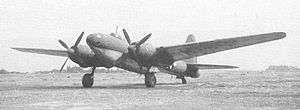Tachikawa Ki-74
| Ki-74 | |
|---|---|
 | |
| Role | Long-range reconnaissance bomber |
| Manufacturer | Tachikawa Aircraft Company |
| Designer | Jiro Tanaka (in the final stage of the development from the summer of 1944 until August 1945)[1][2][3] |
| First flight | March 1944 |
| Primary user | Imperial Japanese Army Air Service |
| Number built | 16 |
The Tachikawa Ki-74 was a Japanese experimental long-range reconnaissance bomber of World War II. A twin-engine, mid-wing monoplane, it was developed for the Imperial Japanese Army Air Service but never deployed in combat. The Ki-74 was designed for high altitude operation with a pressurized cabin for its crew.
Development
Though already conceived in 1939 as a long-range reconnaissance aircraft capable of reaching west of Lake Baikal when operating from bases in Manchukuo (Manchuria), the initial prototype Ki-74 only first flew as late as March 1944, after its development and primary mission requirement had been changed to capability of bombing and reconnaissance over the mainland United States.[4] The aircraft was powered by two 1,641 kW (2,201 hp) Mitsubishi Ha-211-I [Ha-43-I] radial engines. The subsequent two prototypes were powered by the turbo-supercharged Mitsubishi Ha-211-I Ru [Ha-43-II]; these experienced teething troubles and the following thirteen pre-production machines substituted the Ha-211 Ru engine for the lower-powered but more reliable turbo-supercharged Mitsubishi Ha-104 Ru (Army Type 4 1,900 hp Air Cooled Radial).[5] The aircraft was fitted with self-sealing fuel tanks, armor and a pressurized cabin for its crew of 5.[6]
Operational history
The Ki-74 did not progress beyond developmental testing to see operational service in combat. Nevertheless, the Allies knew of the type's existence and assigned the codename "Patsy" after it was discovered that it was a bomber, not a fighter (previously it had been assigned the codename "Pat" in Allied Intelligence).[7]
Specifications (Ki-74)
Data from The Imperial Japanese Secret Weapons Museum ;[8] Japanese Aircraft of the Pacific War[7]
General characteristics
- Crew: 5
- Capacity: 9,200 kg (20,300 lb)
- Length: 17.65 m (57 ft 11 in)
- Wingspan: 18.6 m (61 ft 0 in)
- Height: 5.1 m (16 ft 9 in)
- Wing area: 80 m2 (860 sq ft)
- Empty weight: 10,200 kg (22,487 lb)
- Gross weight: 19,400 kg (42,770 lb)
- Powerplant: 2 × Mitsubishi Ha104 Ru turbo-supercharged 18-cylinder air-cooled radial piston engines, 1,500 kW (2,000 hp) each
Performance
- Maximum speed: 570 km/h (354 mph; 308 kn)
- Cruise speed: 400 km/h (249 mph; 216 kn)
- Range: 8,000 km (4,971 mi; 4,320 nmi)
- Service ceiling: 12,000 m (39,000 ft)
- Wing loading: 242.5 kg/m2 (49.7 lb/sq ft)
- Power/mass: 0.154 kW/kg (0.093 hp/lb; 0.206 hp/kg)
Armament
- 1 x 12.7 mm (0.500 in) Ho-103 machine gun
- 1,000 kg (2,200 lb) bomb load
See also
Aircraft of comparable role, configuration and era
References
Notes
- ↑ Carmakers owe success to warplanes – Military's brightest aircraft designers created Japan's automotive powers The Japan Times, August 13, 2005
- ↑ The History and the Biography of Jiro Tanaka (Detailed PDF document attached) Archived 2015-01-09 at the Wayback Machine. (Japanese) – Japan Automotive Hall of Fame
- ↑ From the Ki-74 to the Tama Electric Vehicles and the Prince Vehicles – Interview of Jiro Tanaka on Nov. 22, 1996 (Japanese) – The Society of Automotive Engineers of Japan (JSAE)
- ↑ Francillon 1979, pp. 259–260.
- ↑ Francillon 1979, pp. 260–261.
- ↑ Francillon 1979, p. 260.
- 1 2 Francillon 1979, p. 261.
- ↑ "The Imperial Japanese Secret Weapons Museum". Archived from the original on October 27, 2009.
Bibliography
- Francillon, René J. (1979). Japanese Aircraft of the Pacific War. Putnam Aeronautical. ISBN 0-370-30251-6.
External links
| Wikimedia Commons has media related to Tachikawa Ki-74. |